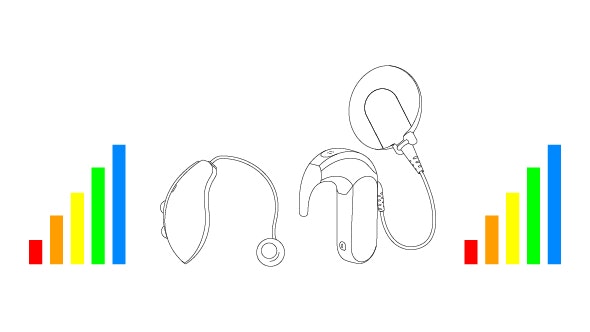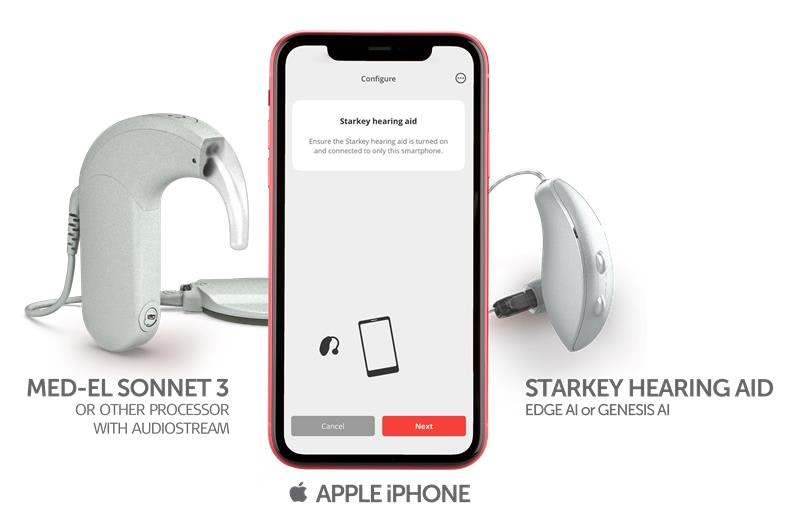Bimodal Hearing With a Cochlear Implant and a Hearing Aid
If you have moderate-to-profound hearing loss on one side and milder hearing loss on the other, a bimodal hearing solution might be the right choice for you. This approach combines a cochlear implant in one ear with a hearing aid in the other. The result? Better sound clarity than you would have with just a hearing aid or a cochlear implant on its own.
Read on to learn more about the difference between a hearing aid and a cochlear implant and how they could help you hear closest to natural hearing. We're especially excited for you to learn more about our DualSync technology through our partnership with Starkey.

The Benefits of Bimodal Hearing
If you’re struggling to understand conversations with hearing aids alone, it might be time to consider a bimodal hearing solution.
With a bimodal hearing solution, you use both of your ears. This makes it easier to hear in noisy environments like restaurants and family gatherings. You’ll also need less mental effort for listening. This is important because it can mean less exhaustion from everyday noise.
Using both ears also makes it easier to tell where sounds are coming from. Overall, hearing with both ears can significantly improve your quality of life.
- Significantly better speech understanding in noise
- Much less listening effort
- Reduced social isolation
- Better sound localization
- Improved quality of life
“Thanks to this combination of cochlear implant and hearing aid, many everyday things have become easier, for example having conversations or watching movies.”
Antonio, bimodal MED-EL user
Want more information about bimodal hearing with MED-EL?

Hearing Aids vs Cochlear Implants
Hearing aids and cochlear implants are both common solutions for hearing loss. However, they work very differently and are used for treating different levels of hearing loss.
Hearing aids can be useful for mild-to-severe hearing loss, but they only amplify sounds. This means they can’t effectively treat more profound levels of hearing loss.
If your hearing loss gets worse, a cochlear implant may be a more effective treatment option. Cochlear implants work by stimulating the inner ear to send sound signals to your brain. If the strongest hearing aid isn’t working for you, a cochlear implant can be an effective option for helping to restore hearing.
Hearing Aid
- Amplifies sound
- For mild-to-severe hearing loss
- No surgery
- Worn in or behind the ear
Cochlear Implant
- Stimulates the inner ear to send sound signals to the brain
- For moderate-to-profound hearing loss
- For when a hearing aid is no longer enough
- Implant placed under skin, audio processor on or above ear
Watch How MED-EL Cochlear Implants Work
“I really like the combination of the sound of the cochlear implant and the hearing aid! However, for understanding, the implant is essential. I can follow what the people sitting to my right say much better. I can localize and actually hear sounds that I can’t with the hearing aid.”
Anette, bimodal MED-EL user

Bimodal Hearing With a Cochlear Implant
Cochlear implants and hearing aids work differently, but they can also work together as a bimodal hearing solution.
In fact, MED-EL cochlear implants can work with any brand of hearing aid. This is because our cochlear implants offer closest to natural hearing.
Bimodal With MED-EL
At MED-EL, our philosophy is to provide a closer match to natural hearing with our cochlear implants. The idea is simple: Provide a closer match between both ears so that both ears can work better together.
This makes it easier to match any hearing aid, including the hearing aid you’re wearing right now. By letting both ears hear their best, both ears can work together better.


Bimodal Hearing With MED-EL
There are all sorts of reasons why using a MED-EL cochlear implant and a hearing aid together makes sense, including:
- Closer to natural match between ears
- Full range of sounds to both ears
- Better music enjoyment
- Significantly better hearing in quiet and noise
- Less listening effort
- More natural sound quality
- Improved ability to locate sounds
- Compatibility with any hearing aid
- Stream sound to both your ears
Bimodal Streaming
Enjoy streaming music and phone calls to your hearing aids? You can also do this with your cochlear implant! MED-EL’s bimodal streaming system allows you to send sound simultaneously to both your cochlear implant and your hearing aid.
Bimodal Streaming With Apple
Stream sound directly from your Apple device to your MED-EL audio processor and a Starkey Edge AI or Starkey Genesis AI hearing aid.
Bimodal Streaming With Android
Stream sound directly from your Android device to your MED-EL audio processor and a hearing aid equipped with Audio Streaming for Hearing Aids (ASHA) technology.
Bimodal streaming is available with the SONNET 3 audio processor as well as via AudioStream for SONNET and SONNET 2 or the AudioStream Adapter for RONDO 3. For an up-to-date list of compatible devices and hearing aids, please see the relevant technical data.
.jpg?auto=format&sfvrsn=6ae23241_1)
DualSync Technology From MED-EL and Starkey
Unique DualSync technology makes it simple to stream from an Apple device to your MED-EL audio processor and your Starkey hearing aid simultaneously. Thanks to this partnership, Apple devices will recognize your audio processor and your hearing aid as a pair, streamlining the bimodal pairing and streaming process.


Apple and the Apple logo are trademarks of Apple Inc., registered in the U.S. and other countries and regions.


The Next Steps
What are the next steps for getting a cochlear implant?
1
Assessment
First, your audiologist and clinical team will need to determine if a cochlear implant is an option for your hearing loss. If you’d like help finding a cochlear implant audiologist near you, please let us know with the contact form below.
2
Implantation
If a cochlear implant is the right solution, the next step is implantation. This is a safe and routine surgery that takes about an hour or two. Your doctor may have you stay at the hospital for a day or two. You should be back to your daily routine after a few days.
3
Activation
About four weeks after implantation, the implant can be activated. Your cochlear implant audiologist will program the implant for you and show you how to use everything. You can keep using your hearing aid together with your implant.
4
Rehabilitation
After activation, you will need to learn to understand sounds with your implanted ear. Daily listening exercises are very important to help maximize your benefit. These rehabilitation exercises can be done together with a hearing professional or at home.

A Lifetime of Hearing
At MED-EL, we’ve been connecting families with life-changing hearing implants for more than 30 years so we understand that hearing loss can be difficult for you and your whole family. That’s why we’ve always been driven by one thing: A passion to help people with hearing loss.
It’s been that way since 1977, when our CEO, Dr. Ingeborg Hochmair, pioneered the modern cochlear implant along with her husband Erwin. Today we’ve grown to more than 3,100 employees covering 137 countries, but we’re still guided by the steadfast principles of our founders.
Our dedicated support network and local care specialists ensure our recipients are always well cared for. And when we create new technology, we make sure it’s compatible with earlier implants so that everyone can benefit. With MED-EL, our recipients know they can always count on us for a lifetime of better hearing.
When you’re ready to take the next step, we’ll be here with you every step of the way.


